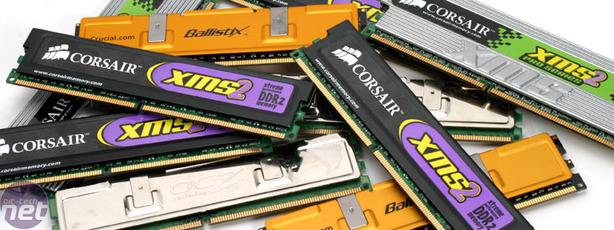Core 2 Duo: Effects Of Memory Timings
July 18, 2006 | 16:18

Rounding things up...
There are some scenarios where tighter memory timings do improve performance on Intel's brand new Core 2 Duo processors. The improvements are not limited to either Conroe or Allendale either, as both the 2MB L2 cache and 4MB L2 cache versions of Core 2 Duo showed similar performance gains in certain applications.If we disregard the synthetic benchmarks that were designed to show the theoretical performance advantages of running tigher memory timings on a Core 2 Duo processor, we will run through the highlights on both the Conroe-based Core 2 Duo E6600 and the Allendale-based Core 2 Duo E6400.
With the Core 2 Duo E6600, we found that there were small gains in performance in Adobe Photoshop Elements 4.0, Xvid Encoding, LAME MT MP3 encoding with the Intel Compiler, file compression and multi-tasking. Most of the time, these differences were small - the largest improvement was found in our large file compression and encryption test.
The situation was pretty similar on the Core 2 Duo E6400 too, but there were some tests where the incremental performance differences changed a little. For instance, we saw very little difference in performance between 3.0-3-3-9 and 5.0-5-5-15 memory timings during our two multi-tasking tests. The landscape changed a little in our WinRAR file compression and encryption tests too. Performance differences in the large file test were smaller than they were on the 4MB L2 cached E6600, but the differences were larger when compressing lots of smaller files.

Final Thoughts...
It seems that memory timings do make a little bit of difference, but not as much as we were expecting, in all honesty. We think that a lot of this is down to the fact that Intel's Israeli design team managed to architect an incredibly efficient way of reducing memory accesses. Both cores can share the same L2 cache meaning that the two cores can share one copy of the data and it also eliminates the need for cache coherency traffic to be passed through the memory controller, reducing traffic going across the front side bus.That said, cheap memory isn't going to be ideal if you're looking to heavily overclock a Core 2 Duo processor. That reason alone means that there are still inherent benefits to buying the more expensive memory. It's quite worrying to think that 2GB of Corsair XMS2-6400C3 - rated at 3.0-4-3-9 and capable of 3.0-3-3-9 based on our own testing - costs nearly twice as much as an otherwise similarly specified pair of XMS2-6400C4 modules. Especially when you consider that the performance improvements are small.
However, if you're looking for the ultimate companion for your Core 2 Duo processor, you're going to have to pay the price for something like Corsair's 6400C3 modules. For those that are content with good but not class-leading performance, a pair of 1GB DDR2-800 modules rated at 4.0-4-4-12 will serve your Core 2 Duo incredibly well.

MSI MPG Velox 100R Chassis Review
October 14 2021 | 15:04








Want to comment? Please log in.